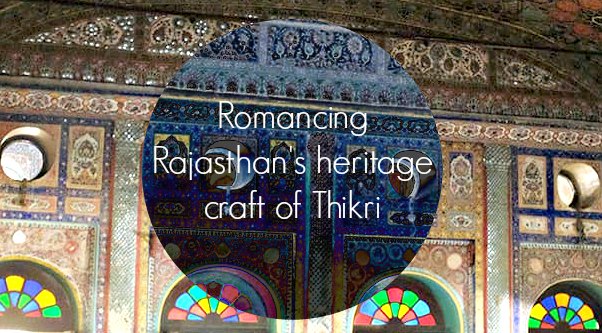We just can’t get enough of the beautiful city of Udaipur, located in the colourful and heritage rich state of Rajasthan. After our last story INSIDE TAJ LAKE PALACE: Decoding its interior , continuing with the romance for this city, this week we get you the story on the heritage craft of Thikri. The art of inlaying hand cut pieces of mirrors using diamond scalpels into perfect shapes and arranged into frescos on the ceiling and the walls to form geometric mirrored mosaic patterns is known as “thikri” or mirror inlay or glass mosaic.
This time around, we have gone rummaging into the treasure trove of Indian arts and crafts to bring you insights on thikri, a heritage craft about 400 years old, which is finding itself in contemporary recreations with help of dedicated artists and exponents such as the one we introduce you to, going further.
Photo courtesy: Gaatha
A beautifully detailed example of colorful glass inlay work, this is the kind of rich and regal design that comes alive with thikri work on palace walls and such
An old traditional artform from Rajasthan, where limestone, the base for thikri, abounds, thikri work makes for beautifying the walls, ceilings, niches of a house and even panels, tiles and furniture. This work can be seen in many of Rajasthan’s landmark palaces and heritage kothi’s, including the famous Amer Fort and Jaipur’s City Palace, where the ceilings, walls and niches in the Baradari café stands testimony to this heritage art form.
A peek inside the gorgeous mirror mosaic-ed walls of Amer Fort in Jaipur, Rajasthan.
An exponent of this age old art form, and an expert craftsman working under the banner, Glass Inlay, Rajesh Anant has been at the helm of keeping thikri work alive since the 1980s, as he operates out of his Udaipur base. Specialising in thikri work on glass and wood panels, on tiles, décor artifacts and much more, his work spans a whole range of spaces – from hotel interiors and facades to elaborate wedding and movie sets.
A beautiful thikri work panel created by artist Rajesh Anant himself at Glass Inlay in Udaipur
Credited with the beautiful sheesh mahal for the Salman Khan starrer, Prem Ratan Dhan Payo, he is also the creative force behind the thikri work adorning the walls of such heritage properties in Rajasthan like the Devigarh Palace Hotel, Rambagh Palace Hotel, Mehrangarh Fort Palace and more.
Bringing traditional art forms to add an ethnic touch to regular furniture, here is a trunk gleaming with glass inlay work, a statement piece indeed
Working with his skilled team of ten to twelve people, Rajesh Anant promises high quality and precision along with other plus factors such as easy ordering, packaging, payment and delivery processes for those who want to commission him for thikri work. What sets this artisanal craft apart is the fact that it involves handiwork and stresses on manual aptitude. While the name thikri in Mewari refers to the shards of a broken pot/earthenware, the process still involves the use of kilns or desi bhattis.
View inside the Oberoi’s Udaivillas Palace, Udaipur.
A labour of love, thikri work is an art form which is handed down generations of artisans in Rajasthan who strive to keep it alive beyond the decades
Although the pressures of keeping such manual-intrinsic crafts alive in modern times abound, thikri remains a time-consuming art form. Depending on the scale of work involved, a wall in a standard room can take upto a month to complete, and this should actually make on revel in it, like the yesteryear’s patron who patiently waited for his commissioned portraits to come to life. You can find more about Mr. Rajesh Anant on his website http://www.glassinlay.in
Still wanting more? Follow us on Instagram or Facebook to get more juice on this story.









